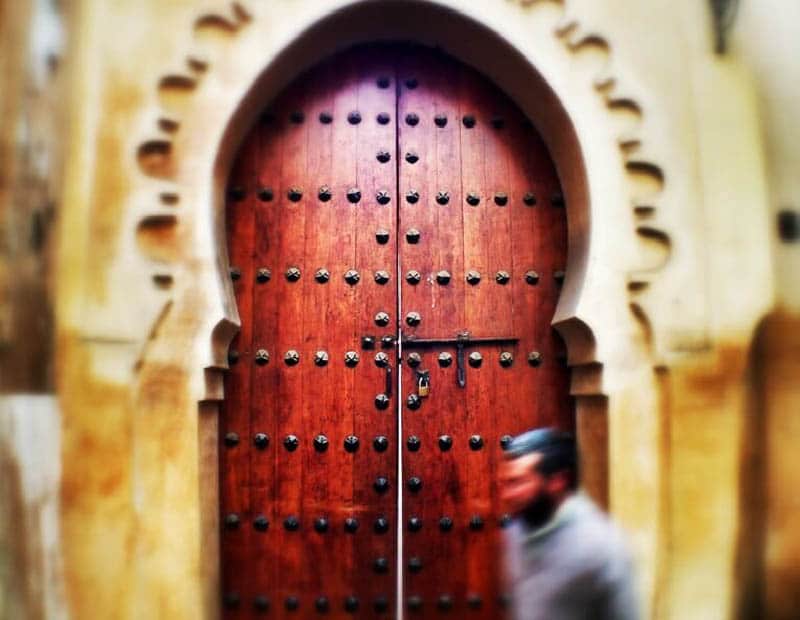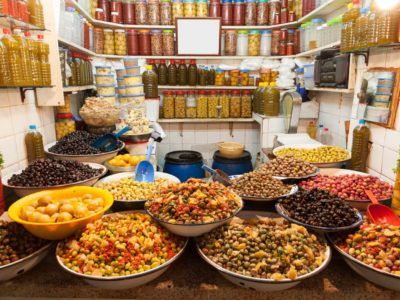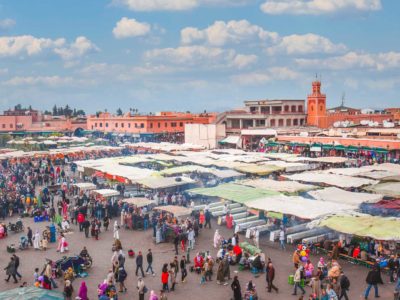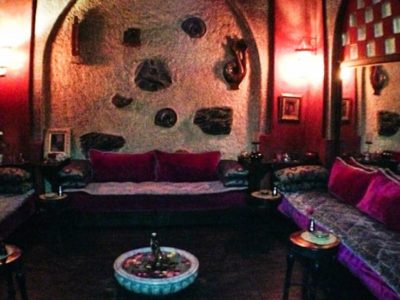Morocco is a fascinating multicultural country blended from African, Arab and European influences.
It is our closest link to the continent of Africa and a diverse holiday destination.
The country offers an incredible amount of history, culture, art, and music along with a fascinating geographical landscape incorporating the Sahara desert, the snow-capped Atlas Mountains and the Atlantic coastline.
This Morocco travel guide will help you plan your next vacation.
Table of contents
Table of Contents
Fast Facts about Morocco
- Moroccan power voltage is 127/220 V 60 Hz; Power sockets C & E
- The local currency is the Moroccan Dirham (MAD) and is around 9.50 MAD to 1 USD
- In the north of Morocco, visitors will find the Spanish enclaves of Ceuta and Melilla, claimed by Morocco and considered by the Moroccan state to be “occupied territory.”
- In these two towns, the main currency is the euro.
- Tipping is a way of life in Morocco; almost any service can warrant a tip so make sure to bring small bills.
- Haggling is also a way of life in Morocco.
- NEVER pay the asking price, vendors often double or even triple the prices of an item to allow some wiggle room through the haggling process.
- If you are not Muslim, you are not allowed in many of the mosques. Exceptions include the partially restored Almohad structure of Tin Mal in the High Atlas, the similarly disused Great Mosque at Smara in Western Sahara, the courtyard of the sanctuary-mosque of Moulay Ismail in Meknes and the Hassan II Mosque in Casablanca.
- Moroccan laws towards alcohol are quite liberal however drinking alcohol in public places is not recommended. During Ramandan, try to avoid drinking, eating or smoking in public during the hours of fasting.
- SIM Cards:
Things to See and Do in Morocco
- Enjoy a Four-Wheeling Adventure– join the guides of Dunes Desert Exploration and take a three hour tour in the desert on your very own dune buggy or quad bike.
- Surf’s up – Taghazout is a small fishing village 19 km north of the city of Agadir in the southwest of Morocco and houses some of the country’s best surf spots. It is nestled amongst a set of small bays just south of the legendary surf breaks of Anchor Point, Killers, and Mysteries.
Culture
- Go to a Hammam – A Hammam is a hot steam bath followed by a massage. Sounds simple enough doesn’t it? It definitely can be quite the experience!
- Visit Fes – Fes is the oldest city in the country and the Medina (or Fes el-Bali) is a World Heritage site. Fez is also famous for its leather products and most of it comes from the leather bazaar (souq). The souq is home to three ancient leather tanneries, the largest and oldest being the Chouara Tannery, which is almost a thousand years old.
- Take a cooking course – learn how to cook traditional Morrocans dishes from a gourmet chef while enjoying great conversations, appetizers and tea.
- Watch the sun rise on a Merzouga morning – to experience a desert sunrise is an unforgettable experience and the best place to do so is at the Merzouga sand dunes of Erg Chebbi
- Take in the colors of the Dades Gorge – There is nothing in the world quite like the Dades Valley. The mineral-rich Dades Gorge sparkles in many hues of blue and green as well as white and red.
- Spend a day in Jemaa el Fna in Marrakech – one of the main cultural spaces in Marrakech, this square has become one of the symbols of the city.
Morocco Travel Guides
Budgeting
Accommodation
Budget: You can find a variety of hostels from 53-175 MAD per night. Enjoy dorms or private rooms, free breakfast, hot showers, and central locations to nearby tourist destinations. The Riad Verus in Fes even offers free Arabic classes.
Mid-Range: For mid-range, expect to pay around 380-860 MAD per night. These hotels come with a hotel restaurant and bar, rooms with flat-screen TVs and free Wi-Fi, a swimming pool, and room service.
High-End: For five-star hotels, you will pay around 860-4,100 MAD per night.Take in the best withspa services, fine dining, swimming pools with lounge areas, refined private suites with living rooms, a fitness center, and an airport shuttle.
Food
Moroccan cuisine has a variety of influences, including Arabic, Berber, Mediterranean, and Andalusian cuisine, among others. Staples include fruits, vegetables, meat (beef, goat, lamb, and mutton), seafood, grapes, olive oil, and spices.
Couscous is a popular dish and is often served with meat or vegetables. Morocco also has a vibrant street food scene, where you can sample dishes like harira (a soup made from tomatoes, lentils, chickpeas, lamb, rice, and spices such as cinnamon) or merguez (minced beef or lamb sausages served in flatbread). There are sit-down restaurants as well where you can try more of Morocco’s cuisine. In total, expect to pay around 120 MAD per day for food. Read our full article 13 Delicious Moroccan Foods to Eat When Visiting Morocco
The Best Ways to Get Around Morocco
Getting to Morocco:
Flights: Morocco has 25 airports, but the main airport to fly into is the Mohammed V International Airport, located 15.5 miles from the city center of Casablanca. Another popular airport is Marrakesh Menara International Airport (4.6 miles from downtown Marrakesh), but the flights are mostly from Europe. You can check for the best flights to Morocco on Skyscanner.
Transportation:
Buses: Buses are good for traveling between cities. For more local trips between towns, expect to pay 3-5 MAD, or to go between cities, expect to pay between 210-340 MAD. A bus trip from Casablanca to Marrakesh, for example, will cost about 210 MAD.
Car Rental: To rent a car, you need to be at least 18-21 years old with a U.S. driver’s license that you have held for 1-2 years. Car rental prices start at 450 MAD per day for drivers 25 and older.
Taxis: Taxis are another way to get around. There are two types of taxis in Morocco: Petit and Grand. Petit taxis can seat up to 3 passengers, are metered, and only travel in the city, while Grand can seat up to and travel outside of a city. Grand taxis tend to have a fixed rate of 10.5 MAD for in-city travel.
Uber: Uber is not available at the time.
When to go To Morocco
For cheaper hotel rates and fewer crowds, visit Morocco during the shoulder seasons of April-May and September-November. The fall season in particular is a great time for hiking.
During the summer months of June-August, temperatures can get very hot, especially the closer you are to the Sahara, while winter months see more rainfall, which can dampen outdoor activities.
Where to Stay in Morocco
Hotel Moroccan House Casablanca: When in Casablanca, stay in this beautifully decorated hotel. Featuring traditional Moroccan-styled rooms, amenities include massage services, a restaurant, a hammam, and breakfast. For those who want to explore more of Casablanca, the tram station is just a 3-minute walk away.
Riad Rcif: Come stay in a restored 14th-century palace at this unique hotel in Fes. Featuring colorfully decorated hotel rooms with artwork and glass-stained windows, the hotel also comes with a restaurant, a roof terrace with great views of the city, room service, and free breakfast. The Ibn Danan Synagogue is just 1.5 miles away.
ibis Marrakech Centre Gare Hotel: Just a short trip to Jemaa el-Fnaa square, Majorelle Garden, and the Koutoubia Mosque, this popular hotel in Marrakesh is a great place to stay. Swim in the outdoor pool while enjoying the surrounding gardens, watch TV in your hotel room, get drinks anytime at the 24-hour bar, order room service, or dine at the hotel restaurant.
Check out our favorite booking platforms Booking.com, Tripadvisor and VRBO for the best deals on accommodation.
What to Pack for Morocco
Morocco is about the size of France with coasts upon the Atlantic and the Mediterranean Sea and has an arid climate.
The coastal regions generally have a Mediterranean climate, however as travelers move further inland the conditions can become more extreme and elevation can play a role in the changeable weather conditions.
Morocco is also a Muslim country
- Modesty is respected and travellers are expected to follow the country’s etiquette. In villages and small towns, and even in the medinas of large cities, many women still wear the veil and the street is seen as strictly the man’s domain.
- Women travelers should avoid wearing revealing clothes, like short shorts, low cut shirts or thin-strapped blouses.
- Sarongs – I think we have sarongs in every packing list. From covering up when visiting mosques, being used as a towel or keeping cool on a hot night.
- Pack loose clothing with breathable fabric – cover up with fabric you know will breathe, especially if you plan on heading into the Sahara desert or to one of the coastal regions.
- Tunics are a great option as they can be dressed up or down, are lightweight and offer good coverage.
- Footwear – Pack a pair of lightweight, durable and comfortable shoes. Moroccan streets can be dusty and unclean so if you are uncomfortable with the idea of getting your little piggies dirty then opt for closed-toe shoes instead of sandals/flip flops.
- Kleenex / toilet paper – it is quite common that restaurant restrooms do not offer toilet paper to patrons, so make sure you are prepared.
- Also, don’t be surprised if you encounter squat toilets!
See our packing tips: packing list for smart travel
And see our Etiquette Tips for Travel to the Middle East
Morocco Travel Guide: Best Booking Resources
Whenever we travel to we make sure to start with these companies. We have tried a lot of different ones over the years and all of these have consistently proven to be the best when it comes to offering great prices.
We have used every one of these personally and continue to do so.
- Booking.com: This is our go site to when comparing prices for accommodation. It usually has the cheapest prices, especially in Europe and we love their interface. Not to mention you get free cancellation and you are guaranteed the best price.
- Trip Advisor: What we like about Trip Advisor is that we can look at all the reviews and then book our accommodation. TripAdvisor is where we go when we want to compare prices with multiple accommodation providers.
- VRBO: is the main search engine we use when we are looking for a home or apartment rental. It can sometimes be cheaper than hotels and it is the best way to stay in areas that offer a more local feel.
- Hostelworld: With one of the largest databases of hostels in the world, Hostelworld is the go-to site when you are looking for budget accommodation.
- Skyscanner: This is the first place we check for flights. It consistently comes back with the cheapest and best options. It allows us to compare a lot of airlines to get the best price.
- Rome 2 Rio: If you want to see how to get somewhere by plane, train, bus, ferry or car Rome2Rio lays it all out for you as well as related costs.I love how they show it all to you on a Google Map and it works offline.
- Get Your Guide: For all your day trip and city guide needs, we use Get Your Guide. It has the world’s largest collection of things to do with more than 30,000 activities in 7500 destinations.
- World Nomads Insurance: When traveling to Italy you should always have travel insurance. We have found the best bang for your buck is by far World Nomads.
Morocco Travel Guide: Related Articles
To browse all our articles and guides about Morocco click here.




